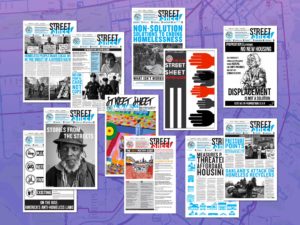‘Homeless: A Day in the Life’ Paints a Poignant Picture of Surviving on the Streets
Why do people end up homeless? For veteran and “former homeless person” Todd Murphy, that question is largely irrelevant. When you’re homeless, you don’t get the luxury of thinking about the whys or the hows. Forced to live in the moment, all that matters is the now, and what you’re going to do at this very second.
That sense of urgency is what drives the narrative of Homeless: A Day in the Life. The novel is a fictionalized memoir of Murphy’s two and a half years spent living on the street. Using his own experiences to guide the story, Murphy recounts the journey of “our friend,” a nameless beggar in a West Coast city.
From the moment our friend wakes up (garbage trucks are his alarm clock), his survival mode starts spinning. Rousing from sleep, he takes mental stock of his inventory that day. Money: One dollar and twenty cents. Tobacco: none. Marijuana: none. Coffee: none. Food: none. Not a great outlook. But on the bright side, at least he didn’t owe anyone money.
Uncertain what the day will hold, all he can do is take it minute by minute. He considers his options: if he finds a cup of leftover coffee, then he can go to 7-Eleven, buy a 60¢ banana, and use their microwave to heat up his coffee for free. That will take care of coffee and food, and still leave him with some money leftover. And as he’s looking for coffee, he can scan the ground for old cigarette butts to use for tobacco. That’s a pretty good start.
And that’s how our friend begins his day. Never thinking too far ahead, yet analyzing the potential outcomes of every decision he makes. This is what it means to be homeless. It’s a life of contradictions, a subtle balancing act as our friend struggles to live within the rules of the law and the rules of the street.
As he moves through his day, our friend spares no expense at describing the realities of his life. He is calm, clear and articulate. He explains the science of making money from dumpster diving (it’s not stealing if you find it in a dumpster), the strategy in taking “showers” in public restrooms (he doesn’t really mind his smell, but he knows it bothers people around him), and what to do if you are ever approached by the police (always say ‘sir,’ act submissively, and don’t talk back).
It’s a harrowing and sometimes brutal account. But it’s not all bad. There’s the friends he’s made, the books he’s lost himself in, and that one time he found a brand new bicycle in the dumpster (he got some good weed out of that). And there is also the unparalleled freedom of not being confined to a schedule, a building, or a boss. The world is his oyster—as long as he follows the rules.
Murphy’s novel offers a rare insight into the life of how just one homeless person can live—but not a typical one, as he is careful to note. There is no such thing as a typical homeless person, he writes. Every single person on the street has a different story, different motivations and a different survival method.
For our friend, it means living in a perpetual gray area—of toeing the line just so, careful not to step too far into a world that shuns him or a world he’s trying to escape from. It’s the push and pull between recognizing the realities of his day-to-day, but also the necessity of seeing the silver lining. He searches for that optimistic thought that can keep him sane—but he can’t be too optimistic, because that could drive him insane.
For those of us who are lucky enough to live outside of this world, it puts us in an awkward position. We marvel at our friend’s resourcefulness, but feel sad that he is driven to such measures in the first place. We’re inspired by his positivity, yet realize he has little choice in the matter if he wants to survive. We feel sorry for the shame he feels, but then recall our own encounters with people like our friend, and how we might have recoiled from them in disgust or fear.
It’s this tension that makes Murphy’s book slightly uncomfortable to read. Our friend has no illusions about what people think of him. He knows the lies the non-homeless tell themselves (“homeless people are just going to use my money for drugs”) and the ease with which we can ignore the homeless around us. But rather than letting our suspicions and prejudices fuel his negativity, he develops far more empathy than anyone in his position should have.
For anyone who has ever wondered what it’s like to live on the street, Homeless: A Day in the Life is a glimpse into a world we try so hard to ignore. Even those who think they have empathy for the homeless are forced to consider the ways in which their own unconscious biases have contributed to their plight. Murphy’s book is not an easy read in the emotional sense, but it offers an eye-opening snapshot into the resilience and brutality of human nature. And above all, it instills the importance of having compassion for everyone around us.
“Someone who’s warm can’t understand someone who’s cold.” – Alexander Solzhenitsyn

